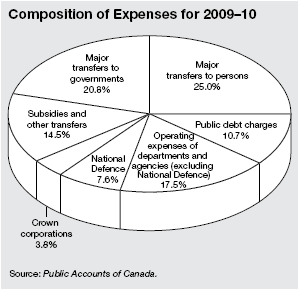The Government of Canada released their annual report for the 2009-2010 fiscal year (April 2009 to March 2010). The headline number is the $55.6 billion deficit.
Although the report is a pleasantly short 30 page read, I will concentrate on the expenditure side of the budget. A lot of people have the impression that federal government spending can be easily slashed. Apportioned by percentage, the $244.8 billion of expenditures look like this:
Looking at the pie chart from largest to smallest percentage expenses, one can easily see how cutting expenditures is not politically feasible. For example, a full quarter of expenses are transfers to persons. These include Old Age Security, EI payments, and child-related transfers – all three would likely have massive backlash if there was a cessation of benefits.
The government in the 1990’s, when faced with a deficit crunch (when a third of the revenues went off as interest payments) decided to cut transfer payments – this goes to the provinces mainly to pay for healthcare. Again, this would be highly unpopular if the government did so.
The discretionary expenses that the government has a chance of implementing are on defence, crown corporations, and “the rest of the government”. This is approximately 29% of the 2009-2010 fiscal expense profile. Even if you were to decrease these expenses, it would make little progress at reducing the entire expense profile, which is ballooning as the population ages.
Every Canadian should be able to understand this document, but sadly, few ever read it.

